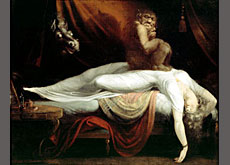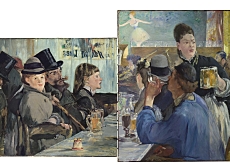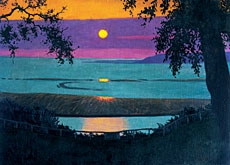Wild Swiss returns from exile

The scandalous life of one of Switzerland's most colourful characters has been brought to life at an art exhibition in Zurich.
Painter Johann Heinrich Füssli earned the tag of “The Wild Swiss” after being forced to flee his native Zurich to live in exile in London, where he shocked high society with his daring pictures.
The Kunsthaus art gallery has brought together a comprehensive collection of his finest paintings from the Romantic Movement and rare sketches that are usually too fragile to display.
The 60 oil and watercolour paintings and 120 drawings are the first major retrospective of the artist in 35 years. The exhibition, called Füssli – The Wild Swiss, runs until January 8.
Füssli was born in 1741 in Zurich, where he studied theology and took holy orders in 1761.
He was drummed out of the city shortly afterwards, however, when he exposed a corrupt magistrate.
He went to Germany and in 1765 he travelled to London at the suggestion of the British Ambassador in Berlin, who had been impressed by his drawings.
Fame and infamy
In 1770 he started his new career as an artist in Rome, but it did not really take off until his return to London in 1779, where he changed his name to Henry Fuseli. He made his last visit to Switzerland the same year.
Füssli announced himself to the London art scene with a series of grandiose paintings based on the literary theme of Milton and Shakespeare, which earned him entrance to the Royal Academy.
But his desire to push the boundaries of art rather than repeat the established genre led to both fame and infamy when he produced his seminal work The Nightmare in 1782.
His depiction of an incubus sitting on a sleeping woman, watched by a leering ghostly horse, scandalised London society with its sexual connotations and break from tradition.
“As much as anything, high society circles in London were outraged that this painting appealed to the middle classes,” Kunsthaus Director Dr Christoph Becker told swissinfo.
“Such works of art were usually bought by the upper class for their mansion houses. But this painting depicted a woman wearing middle-class clothes and was far too daring to be hung in a mansion.”
Saucy reputation
From this moment on, Füssli was branded The Wild Swiss. But far from damaging the artist’s reputation, his new image made him more successful.
Taking advantage of his new-found fame, Füssli painted another version of The Nightmare in 1790.
The Kunsthaus exhibition is laid to imitate an English mansion of the period. Each room reflects a different period of the artist’s development, from the beginnings in the Garden Green section to the images of Dante and Macbeth in the Dungeon.
The exhibition also includes a collection of Füssli’s erotic sketches housed in the appropriately named Blue Room alongside portraits of his wife, Sophia, and other actress “friends”.
“Sophia burned most of his erotic works. The ones that survived were those he had given to friends and acquaintances,” says Becker. “Füssli had a rather saucy reputation.”
swissinfo, Matthew Allen in Zurich
Johann Heinrich Füssli was born in Zurich in 1741 and died in London in 1825.
He acquired the tag The Wild Swiss with his scandalous picture called The Nightmare, painted in 1782.
He changed his name to Henry Fuseli when he moved to London and became known as a “British” artist. He was buried in St Paul’s Cathedral, London.

In compliance with the JTI standards
More: SWI swissinfo.ch certified by the Journalism Trust Initiative



You can find an overview of ongoing debates with our journalists here . Please join us!
If you want to start a conversation about a topic raised in this article or want to report factual errors, email us at english@swissinfo.ch.